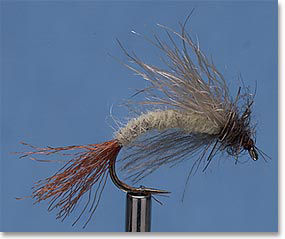Some patterns just have it - that ability to imitate no particular insect or food, yet somehow imitate most all of them and attract the wiliest of trout that have thus far snubbed all other offers. Think the Parachute Adams. The Woolly Bugger. The Pheasant Tail. The go-to fly. The rabbit’s foot that increases your luck. This is Rosenbauer’s Rabbit’s Foot Emerger and Parachute: Flies you simply do not want to be without on the river, especially during a hatch of Hendricksons (or Baetis, or PMDs… you get the picture).
We got together with Tom Rosenbauer to ask him about this proven pattern.
ON: Why do these flies work so well?
TR: Honestly, I don’t know why, exactly. I can surmise though. And I can say, without a doubt, I’ve fooled more trout during more and different hatches - and while prospecting - on this fly than just about any I’ve ever fished. Once, during a Hendrickson hatch on the Delaware, I tied on a Rabbit’s Foot Parachute. I caught three twenty inch browns in short order. I mention this because these are seriously finicky wild trout. That river gets an onslaught of fisherman during this time, fisherman everywhere, and those fish see everything. They refuse a lot of flies that look a lot closer to the real thing than my Rabbit’s Foot. Flies that I swear would work better than this pattern, but don’t. Many times, trout take this pattern when they won’t take much else, or anything else.
 Tom Rosenbauer's Rabbits Foot Emerger |
TR: The hare’s foot fur has a lot to do with it. I was inspired by Bill Phillie’s Usual and some of Galen Mercer’s emergers. It was the first fly that used hare’s foot. I love the buoyancy of the material. It keeps the top half floating while the rest is submerged subsurface, which looks so natural. Plus, that “bugginess,” that slightly unkempt look. Trout seem to really love it.
ON: What else?
TR: I think it’s the sum of the parts. The materials are basic. But as a whole, they add up to something special. The curved nymph hook gives it that great classic emerger profile. It half floats and sits low, the body sits just subsurface. Trout prefer emergers naturally over duns because they’re more vulnerable. They take less energy to consume. And then there’s the Antron shuck that gives the look of a fly that’s just sprouted its wings and is sort of riding its shuck like a raft and is very susceptible. The CDC adds movement and traps air bubbles.
ON: What’s the pattern supposed to imitate?
TR: Originally, a Hendrickson. But now I use it for March Browns, Eastern and Western Green Drakes, BWOs, PMDs. That’s another thing that’s so great. It covers so many hatches. Tied smaller or larger, in different colors, it’s one of those great Hendrickson patterns that you can use in almost any situation when you need some luck. Originally, I spent the length of a Hendrickson season studying the hatch and the big brown trout’s reaction to it. I played with the pattern that whole season. The parachute version I tied a bit later. All I did was raise the wing and tie it upright with parachute style hackle. So you have an indicator. It allows you to float and track the same pattern better in more broken water. Plus, the way a trout’s optics work, the trout sees the wing first, and gets the impression of something floating toward them, so you can attract them from farther away. It really works great as a prospecting fly.
ON: So, it’s worked for you to prospect?
TR: Not just for me. Guides tell me all the time it’s a go-to fly. They ask me if they can put it on their websites. I was on the Bighorn fishing with a bunch of great young guides who were touting a hot pattern they were slaying the trout on. It was their hottest fly. They called it the “Jimi Hendricks” and fished it deep, along the bottom with weight. They said Orvis sold the pattern, but we didn’t sell a fly by that name. Turned out it was my Rabbit’s Foot Emerger. So, you can also fish it deep, with some split shot, and have great luck. That’s when you know a pattern works, when word-of-mouth gets around and people fish it in different ways than intended and call it by different names. All they know is that it works.
ON: That’s all that matters.
TR: Right. I’ve “invented” hundreds of patterns. Maybe ten I still fish that really work. Most of them looked a heck of a lot more refined or spectacular than the Rabbit’s Foot, but none get trout to jump on it like this one. This one is my best. Trout just love it. I won’t hit the river without some in my vest. They really are that lucky rabbit’s foot when you need it. Buy a handful and see if you don’t pick up trout you might not otherwise fool and turn a slow day of fishing into a memorable one.




